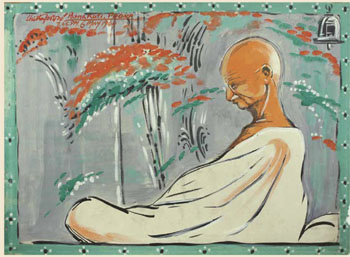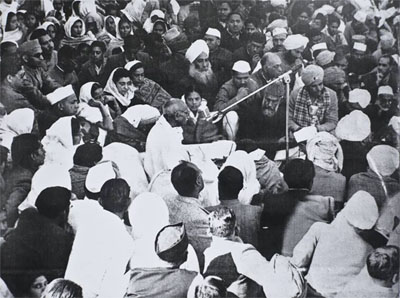|
Gandhi, Secularism, and Cultural Democracy
Vinay Lal
(on the occasion of the birth centenary of Mohandas Karamachand Gandhi, 2 October 1869 – 30 January 1948)

“Gandhiji at Prayer Time, Parnakuti, Poona”, gouache on paper, 1944. The artist is Chittaprosad, the great advocate of the rights of workers and revolutionary artists. Nikhil Chakravarty described in the newspaper People’s War the circumstances under which he painting was done: “Saturday the 6th of May. The papers flashed the news that Gandhiji was going to be released [from the Aga Khan’s Palace, where he had been detained after his call to the nation to “do or die”] at 8. Without a moment’s ado, Chittaprosad and myself took the next train to Poona. Excitement and speculation ran high, but the people as a whole seemed to be as yet too dazed to celebrate it as a day of national jubilation.”
Since the high and the mighty in this ancient land of ours will use the opportunity of Gandhi Jayanti to garland the statues of the Mahatma and spin the usual homilies about the eternal values of truth and nonviolence, values which are being shred to pieces in India, I can turn to the more humble work of attempting to lay out briefly what remains of Gandhi in an India that is increasingly taking the turn towards becoming a Hindu nation. The attacks on Gandhi are coming fast and furious from every corner. His assassin, Nathuram Godse, is being hailed by some Indians as a martyr, a true shaheed. Reportedly, Godse is trending at #1 on Twitter in India. Gandhi’s statues are vandalized and in social media he is accused of the worst atrocities that can be imagined. Yet Gandhi was in his lifetime synonymous with India. When Nehru was once asked what is India, he replied with this short sentence: “Gandhi is India.”
Outside India, as well, his reputation is increasingly under assault, often from those of Indian origin. In Fresno, a small city some 250 kilometres from Los Angeles in California’s Central Valley, over 5000 Sikhs have signed a petition demanding that a bust of Gandhi in the Peace Garden at the local state university be removed because they hold him responsible for the genocide of Sikhs at the time of Partition. Young Sikh students who have not even graduated from high school claim that when they walk by Gandhi’s bust, on which the words “My Life is My Message” have been etched, they feel “traumatized.” Do they even know what “trauma” means? Some of the evidently less thoughtful Black Lives Matter activists have in like fashion convinced themselves that Gandhi was an outright and unrepentant racist, blissfully unaware that every prominent Black civil rights leader in the United States acknowledged standing on Gandhi’s shoulders. The same holds true of the leaders and activists in the anti-apartheid struggle in South Africa and other architects of anti-colonial struggles in Africa, such as Jomo Kenyatta in Kenya and Kwame Nkrumah in Ghana.
One might put it differently: any serious discussion of ideas in the public sphere is becoming increasingly difficult, and in this respect it is not Gandhi alone who has suffered—and similarly it is not in India alone that a frightening ethno-nationalism is now unabashedly on display. Some days ago, I was pleasantly surprised to read that India’s Minister of External Affairs had said publicly that the Buddha and Gandhi were “the two greatest Indians” in the country’s history. That could have been the subject of a substantive discussion and serious intellectual disagreement; rather, the most notable reaction came from Nepal, where they pounced upon the minister for claiming the Buddha for India. The Buddha was, of course, born in Lumbini, which is now in Nepal—but such a reaction, steeped in mind-numbing identitarianism, is befitting the proverbial frog in the well. I suppose that the thousands of books on Indian philosophy which feature long discussions of the Buddha’s sayings, or extracts from the various canons of Buddhist thought, should now be censored since the Buddha cannot be claimed as an Indian. Or perhaps these books should now be classified as works of “Nepali philosophy”. Just as unfortunately, in an act of craven submission, and no doubt with the intention of maintaining friendly relations with a “neighbour”, India’s Ministry of External Affairs at once tendered an apology and admitted that the Buddha is “Nepali”.
Whatever the difficulty, then, of airing ideas, particularly unfashionable ones, in the public domain, the basic proposition of this short essay may now be set out very clearly. It needs to be said, at a time when “Hindu pride” and “Hindu rage” are overtaking the country and making many people in the country feel unwanted, that Gandhi was both a devout Hindu and a firm and resolute believer in secularism. He was also unequivocally clear, particularly in the last few years of his life, that it was imperative for every Indian to stand by secularism. It is necessary to say this in the boldest terms, before parsing secularism in slight detail, since the BJP has for many years spawned nonsense about “pseudo-secularism” and lately gone on a rampage against Nehru as the supposed architect of the idea of secularism in the Indian context. But in truth Gandhi was himself always firmly committed to secularism, though he derived his understanding of it from many different sources and rarely spoke of “secularism” as such. One can go further and even argue that, as he came to witness the flames of communal passion erupting in Calcutta, Bihar, Noakhali, Punjab, and elsewhere in 1946-47, Gandhi would begin to embrace the view that every Indian had to be prepared to subsume his or her religion to the ideal of secularism. Writing in Harijan on 29 June 1947, he put it this way: “Religion is no test of nationality but a personal matter between man and his God. In this sense of nationality they are Indians first and Indian last, no matter what religion they profess.”

Gandhi at the dargah (mausoleum) in Mehrauli (Delhi) of Qutubuddin Bakhtiyar Kaki, a renowned Sufi mystic, saint, and scholar associated with the Chisthi order. His visit took place on January 27, 1948; three days later, he would be felled by three bullets fired by Nathuram Godse.
However, in characterizing Gandhi as simultaneously a “devout Hindu” and a “firm and resolute believer in secularism”, I wish to signify both his differences from Nehru and the fact that, as someone far more attuned to the Indian sensibility than Nehru, Gandhi derived his secularism from a multitude of sources. At the unavoidable risk of simplifying, it may be said that Nehru’s ideas of secularism were derived, generally speaking, from the Enlightenment traditions of the West and, more specifically, from the bourgeois notion of individual freedom and autonomy. It is these same traditions which would in time enshrine the distinction between the private and the public and consign religious belief strictly to the domain of the private. Gandhi was altogether in agreement with this mode of thinking, at least in the last phase of his life, and unhesitatingly declared, more than once in the months before his assassination, that “religion is the personal affair of each individual. It must not be mixed up with politics or national affairs” (Harijan, 7 December 1947). Ten days later, at a public gathering, Gandhi even urged his fellow Indians to disavow their religious identity: “Let there be no Hindus, no Parsis, no Christians, and no Jains. We should realize that we are only Indians, and that religion is a private matter.”
If there was only this much to Gandhi’s thinking, there would have been little to distinguish between him and Nehru. However, where Nehru was a non-believer (nastik), Gandhi had a much more complex and profound relationship to Indian traditions of religiosity. One source of both his religious worldview and his secularism was the bhakti-sufi traditions of India and I would go so far as to argue that Gandhi should be viewed as the last great representative of the sant tradition. His veneration, or rather what I would call “critical veneration”, for Tulsidas is well-known, but the emphasis on that in scholarly work has somewhat obscured his interest in Narasinha Mehta, Mirabai, and Tukaram. But a remark of his, again in the pages of Harijan (31 August 1947), furnishes another set of remarkable cues about his thinking on religion and the public sphere. To quote him at some length, “All subjects will thus be equal in the eyes of the law. But every single individual will be free to pursue his own religion without hindrance, so long as it does not transgress the common law. The question of the ‘protection of minorities’ is not good for me; it rests upon the recognition of religious groupings between citizens of the same state. What I wish India to do is to assure liberty of religious profession to every single individual. Then only India can be great, for it was perhaps the one nation in the ancient world which had recognized cultural democracy, whereby it is held that the roads to God are many, but the goal is one, because God is one and the same. In fact the roads are as many as there are individuals in the world.”
Gandhi was adverting to the ideal of advaita in invoking the multiple roads that lead to God. It is at the same time a characterization of “cultural democracy”. The alert reader may object that, thus far, nothing that has been cited from Gandhi’s writings so much as mentions the word “secularism”, although the same reader may discern the spirit of secularism in Gandhi’s frequent pronouncements on the “liberty of religious profession to every single individual.” But Gandhi did in fact emphatically speak of, and for, secularism: indeed, the preceding passage from the Harijan article of 31 August 1947 says this: “The state is bound to be wholly secular. I go so far as to say that no denominational educational institution in it should enjoy patronage” [emphasis added]. Secularism was the very essence of the “cultural democracy” that, in his reading, characterized the Indian past and perhaps rendered it distinct from other nations. Thus, when Gandhi is calling for a “wholly secular” state, he is calling for the renewal of cultural democracy—a renewal that is perforce necessary at every turn. If contemporary India is finding it so difficult and even offensive to swallow the idea of secularism, supposing it to be a foreign import from the West that colonized the country and still colonizes our imagination, might it find some succour in the idea of “cultural democracy”? It is perhaps time that we started thinking about how the language of “cultural democracy” could be harnessed to furnish all Indians, and especially aggrieved Hindus, with the assurance there is another way of forging a nation without shedding the past.
[Vinay Lal is Professor of History and Asian American Studies at UCLA. He writes widely on the history and culture of colonial and modern India, popular and public culture in India, historiography, the politics of world history, the Indian diaspora, global politics, contemporary American politics, the life and thought of Mohandas Gandhi, Hinduism, and the politics of knowledge systems.]
Courtesy: https://vinaylal.wordpress.com/
Back to Home Page
Frontier
Oct 10, 2020
Prof. Vinay Lal VLAL@HISTORY.UCLA.EDU
Your Comment if any
|
